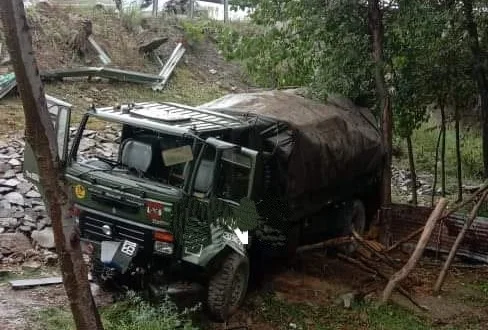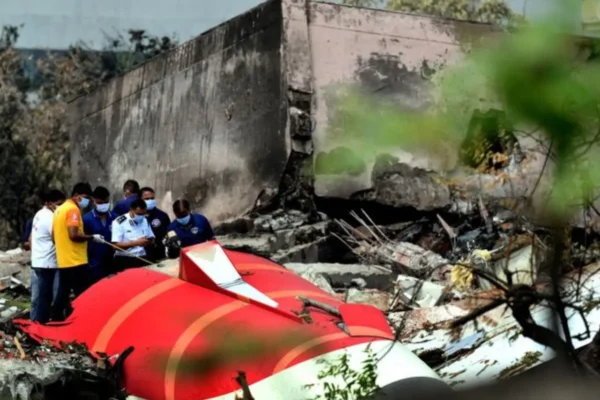

Tragic Army Vehicle Accident in Bandipora: Three Soldiers Lost, Three Injured in Treacherous Weather Conditions
Tragic Army Vehicle Accident in Bandipora: Three Soldiers Lost, Three Injured in Treacherous Weather Conditions
Incident Overview
On January 4, 2025, a devastating accident occurred in Jammu and Kashmir’s Bandipora district when an Army vehicle plunged into a 200-feet deep gorge near SK Bala. The accident, which took place during adverse weather conditions, resulted in the death of three soldiers and left three others seriously injured. The vehicle was part of a military convoy traveling from the Army’s Arin camp to Bandipora when it skidded off the road due to poor visibility and inclement weather.
Immediate Response and Rescue Operations
The rescue operation was promptly initiated through a collaborative effort of the Army’s Quick Response Team (QRT), local police, and civilian residents. The injured soldiers were swiftly evacuated from the accident site, with the local Kashmiri population playing a crucial role in the immediate rescue efforts. This civilian assistance was specifically acknowledged by the Army’s Chinar Corps in their official statement on social media platform X, expressing gratitude for the timely help provided by the local community.
Medical Response and Casualties
Dr. Masrat Iqbal, the Medical Superintendent at District Hospital Bandipora, reported that two soldiers were pronounced dead upon arrival at the hospital. Three injured soldiers received initial treatment at the facility before being transferred to advanced medical centers in Srinagar for specialized care. Another injured soldier, who was taken to the nearby Sonawari hospital, unfortunately succumbed to his injuries, bringing the total death toll to three.
Geographical and Environmental Factors
Local residents provided crucial context about the accident location, identifying it as a particularly hazardous stretch of road. The accident occurred at a blind curve known for its challenging navigation conditions, especially during adverse weather. Mohammad Saleem, a resident living near the accident site, shared historical context about the location’s dangers, referencing a tragic bus accident from two decades ago that claimed 50 lives at the same spot. The area’s proximity to Wullar lake contributes to frequent fog formation, and its position among mountains results in limited sunlight exposure, making it especially treacherous for drivers unfamiliar with the terrain.
Official Statement and Condolences
The Army’s Chinar Corps issued an official statement acknowledging the incident and expressing their condolences. They specifically noted the challenging conditions that led to the accident, citing both the inclement weather and poor visibility as contributing factors. The statement also highlighted the immediate assistance provided by local Kashmiri citizens in the rescue operation, demonstrating the positive civilian-military relationship in the region.
Impact and Historical Context
This incident highlights the ongoing challenges faced by military personnel operating in challenging terrain and weather conditions in Jammu and Kashmir. The location’s history of accidents, as evidenced by the previous bus tragedy, underscores the need for enhanced safety measures and potentially improved infrastructure in such high-risk areas. The immediate response from both military and civilian sectors also demonstrates the existing emergency response capabilities in the region, though the tragic outcome emphasizes the continued risks faced by security forces in their line of duty.
Safety Considerations and Future Implications
The accident raises important questions about safety protocols for military convoys operating in challenging geographical and weather conditions. The historical context of accidents in this particular location, combined with the specific environmental challenges such as limited visibility and difficult terrain, suggests a need for potential review and enhancement of safety measures for military vehicles operating in such conditions. This could include considerations for alternate routes during adverse weather, enhanced driver training for specific terrain challenges, or infrastructure improvements at particularly dangerous points along the route.
This tragic incident serves as a sobering reminder of the risks faced by military personnel even during routine operations and highlights the importance of continued focus on safety measures and infrastructure improvements in challenging terrain. The collaborative response from military, medical, and civilian sectors also demonstrates the crucial role of community support in emergency situations.







Thank you for your sharing. I am worried that I lack creative ideas. It is your article that makes me full of hope. Thank you. But, I have a question, can you help me?
Your point of view caught my eye and was very interesting. Thanks. I have a question for you.
Thank you, your article surprised me, there is such an excellent point of view. Thank you for sharing, I learned a lot.
Your article helped me a lot, is there any more related content? Thanks!
swot анализ рынка метод swot анализа
Looking for second-hand? thrift store We have collected the best stores with clothes, shoes and accessories. Large selection, unique finds, brands at low prices. Convenient catalog and up-to-date contacts.
красивое русское порно https://russkoe-porno1.ru
Want to have fun? melbet drugs Watch porn, buy heroin or ecstasy. Pick up whores or buy marijuana. Come in, we’re waiting
Новые актуальные промокод iherb kod herb для выгодных покупок! Скидки на витамины, БАДы, косметику и товары для здоровья. Экономьте до 30% на заказах, используйте проверенные купоны и наслаждайтесь выгодным шопингом.
курсовые на заказ цена курсовой проект цена
оформить займ онлайн займ онлайн
кредитные займы онлайн срочно займ онлайн срочно без отказа
перевод документов на немецкий бюро технических переводов
cocaine in prague cocaine prague telegram
cocaine in prague https://prague-coca-shop.site
buy mdma prague buy weed prague
buy xtc prague plug in prague
cocaine prague buy cocaine in telegram
cocain in prague from brazil buy mdma prague
Нужна презентация? презентация заказать студенту Красочный дизайн, структурированный материал, уникальное оформление и быстрые сроки выполнения.
plug in prague cocaine in prague
prague drugs buy coke in telegram
Thanks for sharing. I read many of your blog posts, cool, your blog is very good.
joszaki regisztracio http://joszaki.hu
Thank you for your sharing. I am worried that I lack creative ideas. It is your article that makes me full of hope. Thank you. But, I have a question, can you help me?
africain foot telecharger 1xbet cameroun
Свежее и важное тут: http://yopolis.ru/publikacii/5933-klinika-opredelenie-vidy-i-osobennosti-raboty-medicinskih-uchrezhdeniy.html
Read more on the website: https://brian.carnell.com/discussion/topic/verified-business-managers/